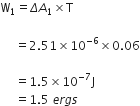Two beakers containing water and honey are stirred rapidly and kept on a table. Which liquid will come to rest earlier?
The coefficient of viscosity of honey is very large as compared to that of water. Therefore, honey kept in the beaker after stirring will come to rest earlier than water.
A soap bubble of radius 10mm is blown from soap solution of surface tension 0.06 N/m. Find the work done in blowing the bubble. What addition work will be done in further blowing to double the radius?



Additional work done in doubling the radius of bubble is,
